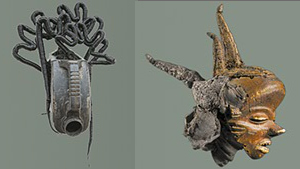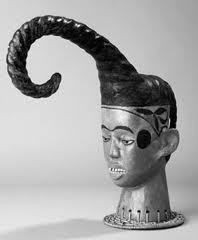The Musée Dapper in Paris was realized by the efforts of the Olfert Dapper Foundation. Dapper was a Dutch historian whose most famous book, Description of Africa (1688), wove geography, economics, politics, medicine, social life and customs. Free of ethnocentric judgments, it remains an indispensable resource for historians.
The museum’s current exhibition, “Initiés, Bassin du Congo,” features 100 works that explore the link between hairdressing in traditional African societies and initiation rites, such as birth, adolescence, marriage, and death. Jean- Paul Notué writes the exhibition catalog, “A hairstyle is an act of socialization and metamorphosis that permits a person to relay their history, social rank, and cultural identity.”

The works on display are architectural, strong, and iconic — an expression of tribal identities that have endured war, political upheaval, and commercialism. You can see many of the museum’s headdresses in this video.
This dramatic headdress belongs to the Lega People, one of the ethnic groups of the Democratic Republic of Congo. The cap was made from fibers of human hair, with a shell decoration in the middle, and buttons decorating the front and strap.

This crest mask is from the Ejagham tribe of Northern Cameroon. Made of one piece of wood, the mask also uses untanned antelope skin, straw, and pigments. It is dated 1928 and was borrowed from the State Museum for Ethnology in Munich.

There is also an installation by contemporary German-Kenyan artist Ingrid Mwangi, who says, “Our own soul immediately plunges the viewer into the heart of the matter: the meaningful content of the hairstyle.”
कंघी
For more scholarly research, please examine our Resource Library and these books:
 Ethnic Jewellery and Adornment |
 African Masks: From the Barbier-Mueller Collection |
 Powerful Headdresses: Africa and Asia |
